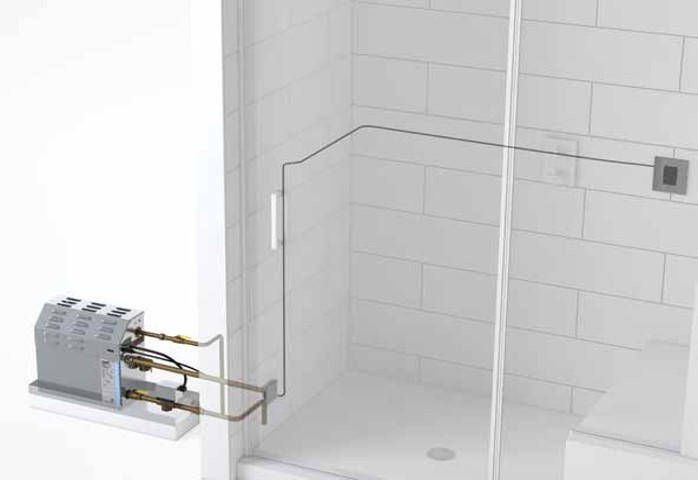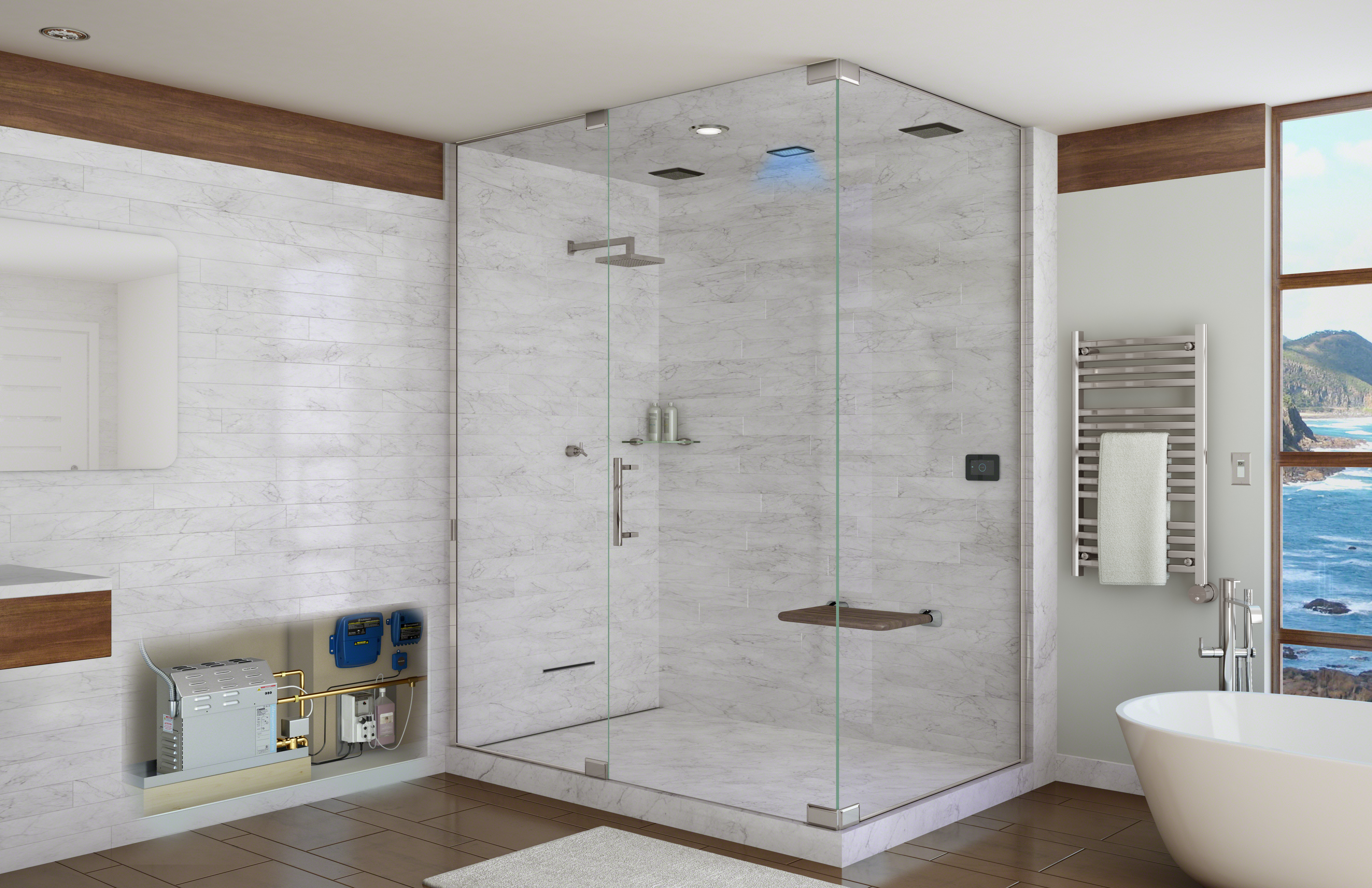Common Mistakes to Look Out for When Installing a Home Steam Shower
The procedure of installing a home steam shower is a step-by-step process that requires the involvement of home professionals, including plumbers and electricians. When done properly, the entire process from design to completion is easy and stress-free. See our blog posts, “Your Top MrSteam Installation Questions Answered” and “How To Install a Steam Generator: 3 Minute Video from MrSteam” to learn more about what you should know before embarking on this project.
But still, it is possible to make steam shower installation mistakes – mistakes that may require additional work to address or may make maintenance more difficult down the road. And who better to tell us about the most common of these potential errors than the people who receive the calls to address them - Vicky Zimberg, Corporate Account Manager and Gabby Gomez, Corporate Account Representative.
Here are their top nine common steam shower installation mistakes – and how you, as home professional or homeowner, can avoid them:
1. Not buying the right-sized generator
It’s important to measure the enclosure properly and to consider what type of materials are on the walls of your shower stall in order to purchase the generator recommended for that space. Choosing a generator that’s too small can mean it isn’t powerful enough; a generator that’s too large will waste power – and neither are energy efficient. A common misstep by homeowners is summed up in this customer statement: “I bought the smallest steam unit MrSteam offers because it’s a ‘small shower’.”

To help address this problem, MrSteam advises both professional home builders and homeowners to take advantage of their Virtual Spa, an all-in-one tool to help plan and customize the steam shower solution. There are five simple steps:
1. Enter shower dimensions and room materials to automatically select the right-sized generator. A homeowner might rely on professional expertise to make sure they are inputting accurate dimensions. In all cases, there are a few criteria to take into account when selecting the right generator size:
-
The steam shower dimensions: length, width, height
-
The materials used, divided into three categories:
-
Natural Stone
-
Ceramic, Porcelain, Glass Tile
-
Acrylic, Fiberglass, Composite
We’ll discuss why knowing more about these materials is critical to the process as part of the next common mistake below.
2. Choose a control package and finish that suits the homeowner’s taste. The various control packages are further outlined here, while specific finishes might be selected in consultation with a designer. Common Error Number 3 addresses what happens when this step is not followed.
3. In consultation with a designer, the homeowner will then want to select items a la carte, including seats and lighting. Many homeowners feel this is the moment to economize, which we address in Common Error Number 4.
4. They can then opt for SteamTherapy accessories to enhance their home spa experience.
5. Finally, they can add a towel warmer from one of MrSteam’s many models.
Once they’ve completed this simple process, either builder or homeowner can print or email their selections, find a local dealer, or even call MrSteam for additional help. Technical specifications are sent automatically with their email.
2. Not recognizing that different shower stall materials can affect the generator size required
The materials the homeowner selects depend on personal taste, but it’s important to consider certain physical properties and address these by selecting the right-sized generator.
The more porous a material, such as marble, shale, granite, glass block, or concrete, the more quickly it dissipates heat. If the homeowner chooses the natural beauty of marble or stone for the steam shower, a more powerful generator is necessary to compensate for the swift heat loss. Conversely, choosing nonporous materials like ceramic, porcelain or acrylic will retain heat in the shower, and a smaller generator will be adequate.
This is the reason why we ask specific material questions in our MrSteam sizing tool – helping you determine the right-sized generator for the materials you’ve selected.
3. Not selecting a control package for their generator
A control package is essential to operate the generator, not just a “nice-to-have” function. They range in price and complexity, from simple to highly personalized, but the generator won’t run without it. Some customers have been known to say: “I just want to turn it on and off,” without fully understanding what features these controls offer and how they might benefit from them.
We have addressed the various types of controls available in our blog post, “Which MrSteam SteamShower Control Is Right for You?” which also includes some handy comparison charts.
4. Not selecting the right accessories and steam therapies during the installation process
MrSteam offers a number of accessories – including wall-mounted seats, recessed lighting, and SteamLinx (where you can control the steam shower using your cell phone) – that are best installed during the initial build or renovation. This is also true for our line of steam therapies – ChromaTherapy, MusicTherapy, and AromaTherapy. Many homeowners wrongly put off adding these features for budgetary reasons and later wish they hadn’t. It is more complicated and costly – as well as disruptive – to install these later on.
5. Ignoring the electrical and plumbing requirements of your home
Often, a homeowner has no clue about the various electrical differences – such as 120v, 208v and 240v. Yet using the wrong electrical outlet can be disastrous, and not being up to code can create issues when your new or renovated bathroom is inspected. The Spruce has a very useful article for someone who wants some education about the various electrical codes and why they are important: “Electrical Code Requirements by Room.”
(And no, despite the customers who have called in and asked, you can’t just “plug the generator in.”)
This is equally true for plumbing requirements – not just for code reasons (though they are important), but so you don’t have issues later such as “sluggish” pipes that release noxious gas into the home. Better Homes and Gardens offers this article if you want to learn more: “A Beginner's Guide to Plumbing Codes.”
6. Improperly sealing the walls, floors, and ceiling for use in the steam shower
You don’t want your steam seeping into the rest of the bathroom and lingering there, causing condensation on the walls and floors. That can lead to accidents due to slipping and mold that can cause health issues. A properly constructed steam shower will drain the steam, so vents are not required. Walls and ceilings must be constructed of water-resistant, non-corrosive surface, such as tile, natural or man-made stone, molded acrylic, or other non-porous material. If you are building a steam room that's not also a shower, a floor drain is required. Windows that are part of the steam room should be double paned and equipped with tempered safety glass. A great resource for information on sealing tile in a shower or steam room is Tile Council of North America.
7. Not storing the generator in an appropriate spot
A MrSteam generator can be installed anywhere within 60 feet of your steam room—in a heated attic or basement, closet, vanity, or similar spot. We recommend leaving 12 inches of excess space on the top and sides for servicing and to ensure adequate ventilation. Do not install the steam generator inside the actual shower enclosure or in an unheated location where the water supply piping might freeze.
It’s important to store the generator in a spot where it can be accessed and parts removed easily to facilitate maintenance. It is also important that the plumbing connection to the generator can be easily turned off if needed.
8. Selecting a contractor, plumber or installer who is not licensed and is not familiar with the installation process
Just because a contractor, plumber or installer has “30 years in the industry” doesn’t necessarily mean they know how to install a steam shower unit. Because steam shower installation involves both water and electricity, MrSteam recommends professional installation by a licensed plumber, electrician, and/or contractor who is familiar with steam. Authorized MrSteam dealers can supply the names of contractors and answer any questions your builder or contractor might have about steam shower installation
9. Not starting with a budget for the renovation of the bathroom, materials, installation costs, and MrSteam products
Having at least a ballpark idea of what installing a MrSteam steam shower - along with the rest of the bathroom renovation - will cost can save the homeowner aggravation and resentment as the project proceeds. Creating a transparent budget with enough leeway to protect both contractor and homeowner will prevent the type of disagreements that often crop up over the course of a renovation.
Our article on estimating the price of installing a steam shower is a good starting point.
Now that you’ve learned some of the most common mistakes in installing a home steam shower, avoiding them will be easy–and enjoying that new home steam shower without the headaches that these errors can create!

 SEARCH
SEARCH
 FIND A DEALER
FIND A DEALER







